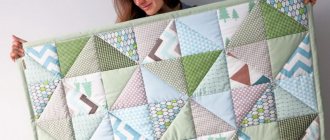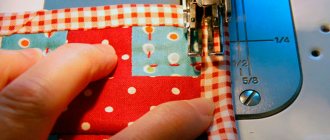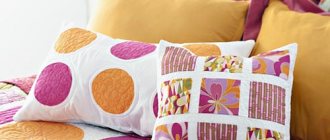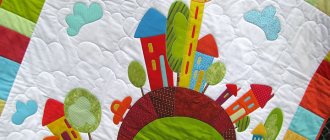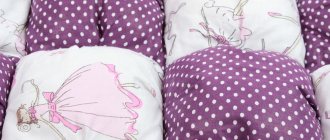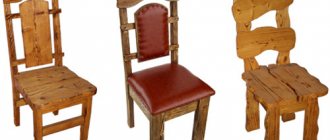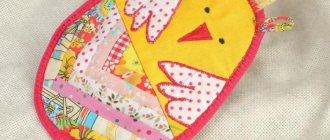creativecommons.org
Making a baby patchwork blanket with your own hands is quite simple. It will take perseverance, creativity and time to create an exclusive item for your baby. Patchwork is becoming more popular every year. Once undeserved technology is again in demand in various fields. Patchwork is used for sewing accessories, clothing, bed linen, and interior items. A baby blanket from scraps can be made with knitting needles or sewn from fabric. The child will surely like both options. A children's set made from pieces of different fabrics, for example, a pillowcase and a warm blanket, looks original. Children's blankets in patchwork style will be an excellent gift for the New Year or birthday. And the baby will remember such a souvenir from a relative for the rest of his life.
How to sew a patchwork blanket
For beginners, it is better to choose patterns with large fragments, this will allow you to make a blanket faster. For experienced needlewomen, there are many master classes that talk about creating complex patterns from small shapes.
Only the upper part of the patchwork cover is made from scraps, and a whole cloth is taken for the bottom layer. This simplifies the work and increases the wear resistance of the product. To sew fragments together with a machine, it is better to use a regular edge stitch. Undoubtedly, linen stitching is stronger, but it may not penetrate fabric consisting of three layers.
Types of patchwork:
- “Quick squares” - patchwork bedspreads are sewn from square fragments.
- “Watercolor” – special attention to color.
- “Strip to stripe” is a blanket made of long rectangles sewn alternately.
- “Log cabin” - in the central part there is a square, and stripes are sewn around it in a spiral.
- “Magic triangles” - simple or complex shapes are made from triangular fragments.
- “Checkerboard” - the blanks are sewn in a checkerboard pattern.
- “Russian square” – multi-tiered sewing.
- “Honeycomb” is a pattern of hexagons.
From denim scraps
And if you have a lot of old jeans and shirts lying around idle in your house, then they can become an excellent source material for a bedspread and even pillows for it.
How to sew a blanket from old jeans?
STEP 1 First
strip out the clothes , leaving only those pieces of fabric that do not have stains, signs of heavy wear, zippers or other accessories. Then wash and iron them. STEP 2 The next step is to cut out squares, triangles or other shapes according to the design or pattern you have chosen. STEP 3 Next, the patches are sewn together 2 at a time, then in strips, then the strips are joined together. STEP 4 Sew on the padding polyester and the lower part of the bedspread. STEP 5 If you wish, you can trim the patchwork bedspread around the perimeter with a satin ribbon, decorate it with beads, sequins or braid .
The resulting product will be dense and wear-resistant due to the properties of denim, and one of a kind.
In conclusion, we can say that patchwork is a fascinating, but very labor-intensive process of matching scraps to each other, and then connecting them to obtain an overall design.
The resulting products will be an original decoration for your apartment and the pride of the needlewoman.
Experience working with fabrics, a machine, as well as perseverance and patience will help you master this unusual style quickly enough. Piece by piece, it will become one of your favorite things to do!
Tips for a beginner on where to start sewing using the patchwork technique
Simple tips to make it easier for beginners to sew patchwork bedspreads with their own hands:
- determine the exact size - a lot depends on this parameter;
- choose a color - the organic nature of the entire product depends on their compatibility;
- prepare the fabric - soak for 10 minutes in hot water;
- To make working with textiles easier, it is recommended to starch and iron it;
- cut into fragments of the required size, leaving allowances;
- prepare the backing textile.
Prepare your tools:
- needle and thread;
- scissors;
- pins;
- sample;
- pencil;
- sewing machine
High-quality edge sealing
Machine finishing the edge of a quilt
There are many ways to create a beautiful edging, the most common is “cheesecake”.
First of all, leave a few centimeters free at the back of the bedspread; if you skipped this step, use a separate wide fabric tape. The backdrop (or tape) needs to be folded over to the front side and a seam made around the perimeter of the product, trying to get closer to the edge of the folded area.
Finishing a blanket with bias tape
We pin the corner of the edging with pins
We attach the binding, checking how the needle catches the lower half of the binding on the wrong side
Working technology step by step
The main stages of making patchwork bedspreads with your own hands:
- drawing a sketch;
- choice of material;
- stitching flaps;
- formation of the finished product;
- Drawing a sketch.
The most important part of the process, because the appearance of the product depends on it. You can draw a sketch on paper, take it from the Internet, or lay it out on the floor from fragments, following the patchwork style. Many ideas on how to sew a bedspread are available in master classes, which greatly simplifies the creation process.
Material selection
Choosing fabrics to match is not easy, but it is very important. The appearance of the bedspread depends on this. In this matter, it is worth relying on the taste preferences of the craftswoman. For two-color products, the only choice rule is dark and light colors. With multi-colored bedspreads the situation is more complicated. Colored fragments should be sewn not in disorderly chaos, but by laying out a pattern, based on existing patchwork patterns.
Technique of stitching flaps
The sequence of actions when stitching fragments is as follows:
- You need to cut two equal strips from textiles of different colors.
- They are folded inside out to each other, stitched, and ironed.
- Now from the textile of the third shade you need to cut a strip equal in width to the first two.
- The third and first two are folded right sides together and stitched.
This technology allows you to make a double-sided sleeve, from which squares are then cut. Next, you need to decide on the pattern, and then you can start connecting.
Fragments of a certain shape are sewn together in pairs if the pattern is complex. Then you should connect 4, 8, and so on until the composition is complete. If the bedspread is made of squares, the joining technology is slightly different. Square blanks are sewn into strips, and after carefully ironing the seams, they are assembled into a finished patchwork product.
Formation of the finished product
When the front part is ready, you should start sewing the back side. To do this, a piece of selected fabric is laid out on any flat surface, face down. If the bedspread is insulated, then a layer of synthetic padding should be placed on the reverse side.
The front side with a patchwork pattern is placed on top, and the product is stitched around the perimeter. The edging is made from a strip of fabric approximately 8 cm long, sewn along the edge. If the edging according to the sketch is wide, then more fabric is needed to make it.
Style Description
Patchwork
The word patchwork translated from English means a product made from multi-colored patches .
Initially, things were made from leftover fabrics for economic reasons. This then grew into the process of creating unique, unusual products.
Patchwork is a very hard and painstaking work that deserves respect and admiration.
Sometimes craftswomen create simply works of art consisting of many small pieces.
These include pillows , napkins, bedspreads and baby blankets of extraordinary beauty .
To work you will need:
- Sewing machine.
- Scraps of fabric.
- Fabric for the reverse side (about 1.5 meters by 2.20).
- Needles and pins.
- Threads in the color of the fabric.
- Well sharpened scissors .
The fabric for shreds can be of any texture, but always with the same density and thickness.
You also choose colors according to your taste, but no more than 6-7 different colors .
- Also, experienced needlewomen in master classes advise taking one color as the main one, and the remaining pieces should be harmoniously combined with it.
DIY baby blanket in patchwork style
For beginners, the “Fast Square” technology is suitable. To make a patchwork bedspread for a girl, you should choose more pink textiles, for boys - blue.
You will need the following materials and tools:
- 4 types of textiles;
- fleece for the back;
- needle and thread;
- ruler, pencil;
- scissors;
- sewing machine.
The simplest option is children's patchwork bedspreads made of 48 squares. To make such a thing, it is enough to cut the prepared fabric into square fragments of the selected size, adding 0.5 cm to allowances on each side. The squares are sewn together in strips, each seam is carefully ironed. When all the strips are ready, you should sew them.
Spread the fleece on the floor, place the front part on it, carefully round the edges with scissors and sew. The child will be happy to cover himself with such a blanket.
Technique
First of all, using the analysis of all photos and descriptions of the materials used to form your idea, you must stock up on all the tools and equipment, and also consider whether the tiles are ready so that the blocks turn out equal.
Your story begins with the following list:
- Fabric sorted into varieties for the top of the blanket;
- Fabric for the bottom of the blanket - lining;
- Various sewing needles: for hand stitching with a large eye, and for a machine;
- Ruler;
- Pins: safe and straight ordinary;
- Threads for auxiliary and main seams;
- Sewing machine.
To assemble the upper part of the product, at which the tiles will connect, we create the desired duvet cover and its image.
We perform the following actions:
- The tiles are sorted, for which fabric is taken according to semantic characteristics;
- Cutting to the required size is carried out;
- We sew together two pieces of scraps, right sides down;
- We connect the stitched pairs together so that the tiles look neat;
- We fold the blocks right sides together and sew them together.
A patchwork quilt is made up of identically sized pieces of fabric of different characteristics.
DIY patchwork bedspread master class
To ensure that all the squares are even, you need to use a ruler. For the same purposes, the fabric is laid in several layers. In our case, the patchwork bedspread will be two-color. Having laid each type of textile in a double layer, we cut off the edge to even it out.
Using a special ruler, mark the width and cut off the strip. You can use a regular ruler, but then it is better to secure the fabric with pins before and after the cutting site.
Here are the cut square pieces, ready for stitching. Their number and size are determined by the dimensions of your product.
The synthetic winterizer also needs to be cut into squares to make the quilted patchwork bedspread warm.
Now you need perseverance. We take a fragment of padding polyester.
Cover it with a yellow cloth.
Turn it over, cover it with textiles with a pea pattern, and secure the “sandwich” with pins.
Now we need to mark the lines in the middle. To do this, take a pen, apply a ruler at an angle of 45 degrees and draw.
When the square piece is stitched diagonally crosswise, you can put it aside and move on to the next one.
The photo shows the process of creating fragments. Also in the left corner there are two stitched squares.
We continue to make preparations.
This is how the fragments will be arranged - in a checkerboard pattern.
First we sew in pairs, then in 4 pieces. The photo shows 3 blanks consisting of 4 squares.
But 8 pieces have already been sewn.
To decorate the seams, you can use scissors to make cuts and unravel the threads. Use scissors carefully so as not to cut the seam.
Sewing a baby patchwork quilt for beginners
Difficulty: low
Working time: 4 hours
Materials: 100% cotton, patchwork fabric, cutter, ruler, cutting mat, sewing machine, scissors
According to the author. If you are expecting a baby and want to make something for him with your own hands or want to make an unusual gift for a child, you can sew him a patchwork quilt. It's not as difficult as it might seem at first glance.
What we need for this:
1. Fabrics for patchwork. I advise you to use high-quality 100% cotton. It does not shrink, does not stain and retains its color for a long time. We will need colored scraps and plain fabric for the background. I will use white and bright fabrics of different colors, you can choose any color scheme. I advise you to use small drawings, since large ones in a block do not always look good. You can buy fabric in the store by the meter, or you can buy ready-made cut pieces of 50*50 cm. I use a piece of white cotton, several 50*55 cm scraps and a few squares left over from other blankets. We will also need fabric for the border (optional).
2. Insulation. Cotton, bamboo or padding polyester. You don't have to buy it right away. It can be purchased once your patchwork top is ready.
3. Wrong side. Again, I recommend 100% cotton, the color can be any, but it’s better if it matches the tone of the patchwork top. You can also buy the backing after creating the top, so it will be easier to decide on the color and size. Basically, patchwork fabric has a width of 110 cm. If you plan to use it for the back of a blanket, you need to calculate the width of the patchwork top no wider than 100-105 cm. Otherwise, you will have to sew the back in two parts or look for a wider suitable fabric.
4. Tools: cutter, cutting mat, ruler, scissors, sewing machine. If you don't have special tools, you can cut everything with scissors.
So this time we will be making quilt blocks.
First you need to prepare the shreds: cut the fabric into squares. The squares can be any size, but I don’t recommend making them small. I will make squares 20*20 cm. The number of colored squares should be equal to the number of white ones. I'll be making a 4*5 block quilt, so I'm cutting out 20 colored and 20 white. If you're in doubt about how much to cut the fabric, you can always cut more as you go.
Be sure to cut off the edges of the fabric! If you use a cutter, you can cut several layers of fabric at once.
When our fabrics are prepared, we can begin stitching the block. To make the “Wings of the Mill” block, take 1 colored square and 1 white square and place them right sides on top of each other. All the beauty of the fabric should be inside. If necessary, chop with pins.
Using a sewing machine we sew the block around the entire perimeter! It is better to use needles for cotton, thicker No. 90, 100. Seam allowances should be the same everywhere! It is very important. I use the standard machine needle position, which gives a 6mm seam allowance.
The red line shows where the stitching should go.
Now we place our block on the mat and cut it diagonally from corner to corner.
We have four triangles. We go to the ironing board and with a hot iron and steam without revealing our part. This way we will relax the seam, it will not wrinkle and will fit better. This must be done every time after sewing the parts together: loosen the seam, open the part with an iron and iron it.
We relax the seam on four parts.
We open the part with an iron. The allowances are pressed onto the dark side. You can always place the triangles with the dark side up and open them with an upward motion of the iron.
We cut off the “ears” that appear.
Now from our four squares you can put together the “Wings of the Mill” block. All your blocks should be stacked the same! For convenience, you can put the first completed block in front of you and stack the rest while looking at it.
It's time to sew our block! First, we sew the halves together: top to bottom (or left to right, whichever is more convenient for you). If you want, you can pin it together. Make sure that the corners lie well and evenly. Since we pressed all the seam allowances onto the dark side, they will blend together perfectly.
We sew on a machine. For speed, you can sew them in a chain, one after the other, without cutting the threads. This significantly speeds up the work.
The result is a chain like this. We cut the thread, relax the seam, and open the parts with an iron. It is important that the allowances are smoothed in different directions. On one side up from the middle, on the other down. This way the middle will fit better and there will be no excess thickness of the fabric. The red arrows show the direction of the allowances.
Sew the two halves together. To make the middle beautiful, we carefully combine the fabric and secure it with a pin. If you pressed it correctly, the seam allowances should be facing in different directions.
We stitch on a machine. We go to the ironing board, relax the seam and open our block. The center should converge at one point.
If it so happens that the block is not quite even at the edges, it can be trimmed. This is one of the few blocks that can be cut to any size. They should all end up the same size. Therefore, it is better to do this at the end, when you have all the blocks ready.
We sew together all the remaining blocks in the same way. You can measure the resulting square and estimate how many blocks are needed horizontally and vertically. My block turned out to be 24*24 cm, therefore 5 blocks in length will be 120 cm minus about 3 cm in allowances = 117 cm. Then a border will be added (more on this in the next master class) and the final size of the patchwork top will be larger.
You can work on several blocks at once, this speeds up the work. For example, first sew several 20*20 squares together, then cut them, sew the parts, and so on. To prevent the parts from getting tangled, pin them together.
So at the end of this step you should have a nice stack of blocks for your quilt. If you want to trim them, trim them all at once, measuring centimeters along a ruler from the middle .
I will be sewing a 4*5 row quilt, so I will need 20 finished quilt blocks.
Lay out the blocks on any flat surface. Pay close attention to how the colors are combined. Do not allow blocks of the same color to stand next to each other. You can take a photo of the laid out blocks and look at the colors in the photo - sometimes it’s better to notice an inharmonious combination. Some masters look through colored glasses or glasses.
Now our task is to sew all these squares together. There may be several options: you can sew four into squares, you can sew in rows, and then the rows can be connected to each other. I prefer the first method, but you can choose whichever is convenient for you.
Before sewing four blocks into a square, I photograph them on a tablet or phone so that during the sewing process I do not forget how the blocks were originally located. Take photos every time before you stitch. It's not difficult, but it makes the job a lot easier.
We pin the blocks in place , otherwise you may forget which sides to sew. We chop the left with the right or the top with the bottom, whichever is more convenient for you.
We sew on a machine. Can be connected with a chain, this speeds up the work. The allowances should be exactly the same as in your blocks! If you sewed blocks with 6 mm allowances, sew all other parts with 6 mm allowances!
Using a hot iron with steam, iron the seam without revealing the details (relax the seam).
After this, we open the stitched blocks so that the allowances point in different directions. This is the time to check the photo. The direction of the allowances is shown by arrows.
This is the time to check the photo. The direction of the allowances is shown by arrows.
If you do everything correctly and carefully, the seams should converge at one point.
Now you need to sew the two halves of the large square. Laying them out on the table again, check the photo and pin down the desired edges. If you press the seam allowances in different directions, the center will fall easily and there will be no excess thickness of the fabric. We stitch on a machine.
We relax the seam and open our square with an iron.
We put it in place the way the blocks were originally located (we check the photo again).
In the same way, by photographing and sewing parts in pairs, we connect all the blocks together.
In principle, this is where you can finish working on the patchwork top. Stitch, border and finish the quilt. But I would like to add a border to make the blanket dressier, larger and give it a finished look.
We select the border to suit your taste, there can be any options - you can use fabrics that are already in the blanket or any new ones. Try and experiment. The border can be thin or wide. If you have fabric, you can put it under the top and see how it looks. If you go to the store to buy border fabric, you can take the patchwork top with you and figure out combinations right in the store.
I will make a thin white stripe and a wide light green one. I wanted to add another thin red one, but then abandoned this idea. Again, to better imagine the future look, you can take a photo and look at the photos to see how it will look.
For the border I need to cut:
- four strips of white fabric, 5 cm wide;
- four stripes of light green, 9 cm wide.
Please note that this width already includes allowances, and the finished border in the blanket will be 1.2-1.5 cm thinner.
We sew the white stripe to the blanket, cutting it right sides together. If you have enough experience in sewing, you can not chop off the border, but apply it to the edge as you sew. I usually sew in pairs to short or long sections of the quilt.
After this, we relax the seam and open it with an iron towards the white border.
Pin and sew the border to the remaining sections. You can make a corner at 45*, but in this master class I will not dwell on this.
Loosen the seam and open it to the white side.
Now we sew on the light green border in exactly the same way.
You can straighten the cuts and remove excess borders immediately with scissors or a cutter after ironing.
Our patchwork top is ready! You can admire and enjoy your work. And also measure it. The size of the quilt top will be the same size as the finished quilt.
We will need:
- Patchwork top.
- Insulation. Its size should be at least 3 cm larger than the patchwork top on each side. Which one is better to choose is up to your taste. You can sew it with padding polyester of various thicknesses, you can choose cotton or wool, you can even use fleece. The only thing I can advise beginners is that it’s better to use thin insulation to begin with. It is much easier to quilt, the layers do not shift and everything turns out much smoother and neater. For example, I will use a thin, light and warm Waltherm.
- The wrong side. It can also be very different: cotton for patchwork, satin, cotton for linen, flannel, fleece or any other. The reverse side can be in harmony with the color of the top or be contrasting. It's a matter of taste. Important: the underside should be 5-6 centimeters larger than the patchwork top on each side.
The width of the fabric is 110 cm for patchwork, 220 cm for cotton on the back of patchwork quilts and the same width for linen fabrics, 150 cm for other fabrics. I will use 150cm wide orange cotton.
- Walking foot for a sewing machine - if you have thick insulation, you can’t do it without it. If the insulation is thin, you can stitch it with a regular foot.
- Curved pins (optional).
- Threads match the back and top and contrast for basting.
- Needles. Curved or straight.
- Masking tape, sold at any good store.
- The large surface is a table, but you can do everything on the floor.
So, iron the back and patchwork top, if required. And attach the back side face down to the table with masking tape. Be guided by the edge of the fabric - in stores they don’t always cut straight, but you can definitely trust the edges. I use a book table. Still, even a small blanket cannot fit on it, but it is still more convenient than doing it on the floor. Firstly, it is inconvenient to sew at an angle (watch your back!), and secondly, this process may take longer than it seems. It won’t be very convenient if your family comes home from work and your entire floor is taken up by a blanket.
Tape the fabric to the table.
Now we apply insulation.
And a patchwork top.
The whole blanket doesn’t even fit on my large table. But when I sew most of it, I can move it without any problems and continue sewing. This method works even for large blankets (200*200 cm and more).
Some craftsmen advise chopping off the layers with special curved pins rather than stitching them together. But I found a couple of significant disadvantages in this method:
1. Pins are thick and leave large holes in the fabric.
2. When working with more or less thick insulation materials, they do not provide the necessary fixation of the layers, and the layers move when stitching.
However, if you find them very convenient, you will save a lot of time.
I use a curved needle that comes straight out. It is considered furniture and is sold in many sewing stores. Choose contrasting threads to make it easier to remove stitches later.
We begin to sew our blanket from the center to the edges, laying horizontal and vertical lines at a distance of 12-15 cm from each other. When going beyond the edges of the blanket, make fastenings.
Be patient, this process is not very fast and not very exciting. Turn on a movie or good music, it will help take your mind off the monotony. I believe that stitching layers is a necessary and very important process and is worth the time!
Turn on a movie or good music, it will help take your mind off the monotony. I believe that stitching layers is a necessary and very important process and is worth the time!
Be sure to stitch along the border and along the very edge of the quilt top! Make the stitches slightly away from the seams, this way you will not sew along them later and it will be easier to remove the basting.
If you sewed the entire piece on the table, peel off the tape and, carefully leveling the layers, move the blanket. Check again to make sure there are no wrinkles on the backing or insulation, tape if necessary, and continue stitching.
If your backing is much larger than needed, you can trim off the excess fabric after basting (within about 5cm of the quilt top). If it doesn’t bother you, you can cut it off after stitching. I had a bit too much on one side, so I cut it off.
If the insulation is thick, you should use a walking foot (sold separately, costs approximately 900-1300 rubles). It has teeth and moves the top layer of tissue simultaneously with the bottom. This prevents the layers of fabric from shifting while sewing on the machine. If the insulation is not thick, then you can get by with a regular sewing machine foot. If you doubt the result, try sewing two layers of cotton fabric with your insulation (making a sandwich like in the blanket itself), and see how it looks in the end. If the layers shift, you will notice it immediately.
This is what our hand basted blanket looks like from the inside out. I don’t sew it diagonally, since these squares are enough.
Threads for a sewing machine. The top thread should match the color of the patchwork top, and the bottom thread should match the color of the backing.
Let's go to the machine and start quilting. The simplest stitch is in the seam, when you stitch along the seam. You can stitch the blanket in any way you like: squares, diamonds, waves or something else. Sometimes it is worth quilting to highlight the patchwork pattern of the quilt. If you quilt very tightly, the blanket will become thinner and stiffer; if you quilt very rarely, the insulation may become loose when washed. It's worth finding a balance here. The blanket should be soft and pleasant, but at the same time washable and durable.
It is not necessary to stitch from the center. You can start from the border. Be sure to backtack at the beginning and end of the lines!
Slowly quilt the entire blanket. I sewed along, across and diagonally the mill, a border around the perimeter.
If possible, it is better to choose to have the needle in the down position when stopping. This makes it easier to move and guide the fabric while sewing.
We sew along the border and be sure to zigzag stitch along the very edge of the blanket.
You can use decorative stitches that are in your machine.
This photo has been specially decolorized to show the stitch pattern.
Now that the stitching is finished, you can cut off the excess backing and the insulation around the edge. Don't damage the zigzag stitch!
Remove all basting lines.
Now... let's admire our work and praise ourselves! All that remains is to trim the edge with piping, and the blanket will be ready!
More on this in my next master class.
We will need:
- Fabric for edging (how to calculate, fabric later in the topic).
- Scissors or cutter.
- Cutting mat.
- Threads match the piping.
First you need to calculate the perimeter of the blanket. To do this, we measure it and add up the lengths of all its sides.
My blanket has two sides of 110 cm and two sides of 132 cm.
110+110+132+132 = 484 cm perimeter.
The edge should be 20 centimeters longer than the perimeter. I like to leave more and will do the calculation for 520 cm of edge.
I still have fabric from the wrong side with a width of 135 cm, therefore we divide 520:135 = rounding, four whole stripes. The piping will be 7 cm wide, folded 3.5 cm. 4 stripes * 7 cm = 28 cm of fabric 135 cm wide.
If you make a edging from fabric 110 cm wide:
520:110 = 5 whole stripes. 5 stripes * 7 cm = 35 cm of fabric with a width of 110 cm for piping. Take a couple of cm more, if the store cuts it unevenly, this happens. In this way, you can calculate the amount of fabric for the edging based on any of its widths.
If you want to make a wider edging, calculate the number of stripes and multiply by the desired width.
We cut strips of fabric with a cutter or scissors. Four stripes 7 cm wide.
These strips need to be connected into a single tape. To avoid excess thickness of the fabric, we connect at an angle of 45 *.
Fold the ribbons right sides together at a 90* angle. For clarity, I drew a seam line; you can also draw lines for yourself with a pencil or chalk and sew along them.
We sew on a machine. Both threads in the machine should match the piping.
Cut off the excess.
Using a steam iron, smooth out the entire edge.
Now fold the edging with the right side out and smooth it along the entire length.
The result is a long strip of fabric folded in half, 3.5 cm wide. This is our finished edging.
Now we apply it to the wrong side of the blanket with the edge towards the edge of the blanket, the fold towards the center of the blanket. Important : do not start sewing the edging from the corner, it is better from the middle.
There is an option to sew the piping first to the front side using a machine, and then manually to the back, but I prefer to sew both sides using a machine for durability and reliability.
If it is more convenient for you, pin the edging with pins. You can apply it as you sew. But be sure to leave at least 10 cm of the tail unsewn at first.
Sew on by machine. Choose the position of the needle and the distance from the edge so that the stitching necessarily covers the zigzag edge of the blanket. Agree, it won’t be very beautiful if a stitching zigzag sticks out from under your stitching.
Not reaching about 6 mm from the corner, we stop and move the line at an angle of 45*.
We put the blanket on the table and make a corner. To do this, bend the edge upward to form a 45* corner.
Now we bend the edging down, the fold of the edging should be flush with the edge of the blanket. If necessary, secure with a pin.
Having stepped back about 6 mm from the edge, we continue to sew the edging to the next corner.
We sew the edging along the entire perimeter in this way and stop about 15-20 cm short of the beginning. We make a tack.
Our task is to combine the edging beautifully into a single piece. We fold the edging and mark with something inside the edging the place where it should meet. Pencil, soap, fabric marker - whatever.
You can directly draw lines inside and sew along them. We fasten the straightened edging with pins and sew it on a typewriter.
Cut off the excess.
Fold it in half lengthwise again and machine sew this piece. The edging is sewn on the wrong side.
Now turn the blanket over with the right side up and, going around the edge, pin the piping to the front side to the piping sewing line (covering it slightly). You can start from a corner.
Sew on by machine. You can also use decorative stitches. It’s more elegant and sometimes even easier to sew on the piping. To lay a beautiful, even stitch along the edge requires some experience and skill; decorative stitches do not require such precision.
When you reach the corner, either fasten the stitching and fold the corners on the table, or you can fold them directly on the machine and sew without interrupting the stitching. As you prefer.
For this colorful blanket, I chose a zigzag stitch. It seems to me that she decorates the blanket. If you are making a blanket for adults or some other classic option, you should rather choose a straight stitch.
After sewing on the edging, the blanket can safely be considered complete!
Almost any not very large baby blanket can be folded into an envelope for discharge. Whether it is square or rectangular does not really matter - the nurses in the maternity hospital will roll up a beautiful little bag from any blanket. All you have to do is buy 4-5 meters of satin ribbon of any suitable color at any sewing store.
Such a blanket will warm the baby not only with warmth, but also with your love and care.
Don't be afraid to try new things, believe in yourself and do everything with love and pleasure! Good luck!
Source
Patchwork bedspread in a modern interior 61 photos
Examples of original ideas can be seen in the photographs. Here are bedspreads made in patchwork style that fit perfectly into the style of the home. Products can be cotton, cotton and others. The color should “echo” the main color chosen for the design of the room.
Handmade things retain the warmth of the craftswoman. The tutorial above shows that even something as large as a bedspread is easy to make. The only thing a beginner may lack in the process is patience.
Author: Galina Kanashchuk
Choosing the right fabric
To sew a blanket from scraps with your own hands, you need pieces of fabric of the same thickness and texture. The color palette of fabrics is selected in accordance with the interior style, wall colors and furniture.
Contrasting combinations of fabrics look most advantageous against the discreet background of the main fabric. You should not allow excess variegation; it is better to give preference to moderation.
Before starting the sewing process, you need to make a preliminary layout of the blanks on the leading base of the fabric, move a little away from it and evaluate the resulting masterpiece. So to speak, a look from the outside will help you understand the success of the combination of design and color scheme.
